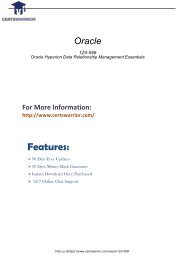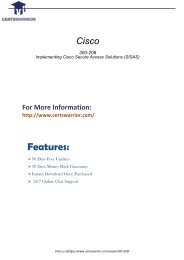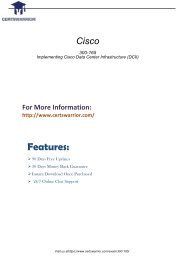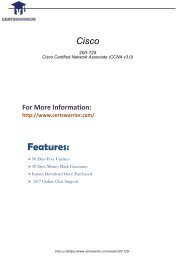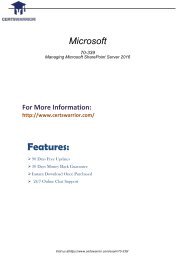200-125 Study Material
You also want an ePaper? Increase the reach of your titles
YUMPU automatically turns print PDFs into web optimized ePapers that Google loves.
How to count them?<br />
Broadcast Domain:<br />
No matter how many hosts or devices are connected together, if they are connected with a repeater,<br />
hub, switch or bridge, all these devices are in ONE Broadcast domain (assuming a single VLAN). A Router<br />
is used to separate Broadcast-Domains (we could also call them Subnets - or call them VLANs).<br />
So, if a router stands between all these devices, we have TWO broadcast domains.<br />
Collision Domain:<br />
Each connection from a single PC to a Layer 2 switch is ONE Collision domain. For example, if 5 PCs are<br />
connected with separate cables to a switch, we have 5 Collision domains. If this switch is connected to<br />
another switch or a router, we have one collision domain more.<br />
If 5 Devices are connected to a Hub, this is ONE Collision Domain. Each device that is connected to a<br />
Layer 1 device (repeater, hub) will reside in ONE single collision domain.<br />
Question: 13<br />
Which three statements accurately describe Layer 2 Ethernet switches? (Choose three.)<br />
A. Spanning Tree Protocol allows switches to automatically share VLAN information.<br />
B. Establishing VLANs increases the number of broadcast domains.<br />
C. Switches that are configured with VLANs make forwarding decisions based on both Layer 2 and Layer<br />
3 address information.<br />
D. Microsegmentation decreases the number of collisions on the network.<br />
E. In a properly functioning network with redundant switched paths, each switched segment will contain<br />
one root bridge with all its ports in the forwarding state. All other switches in that broadcast domain will<br />
have only one root port.<br />
F. If a switch receives a frame for an unknown destination, it uses ARP to resolve the address.<br />
Answer: B, D, E<br />
Explanation:<br />
Microsegmentation is a network design (functionality) where each workstation or device on a network<br />
gets its own dedicated segment (collision domain) to the switch. Each network device gets the full<br />
bandwidth of the segment and does not have to share the segment with other devices.<br />
Microsegmentation reduces and can even eliminate collisions because each segment is its own collision<br />
domain ->.<br />
Note: Microsegmentation decreases the number of collisions but it increases the number of collision<br />
domains.<br />
Question: 14<br />
Where does routing occur within the DoD TCP/IP reference model?<br />
A. application<br />
B. internet<br />
Visit us athttps://www.certsgrade.com/pdf/<strong>200</strong>-<strong>125</strong>/









